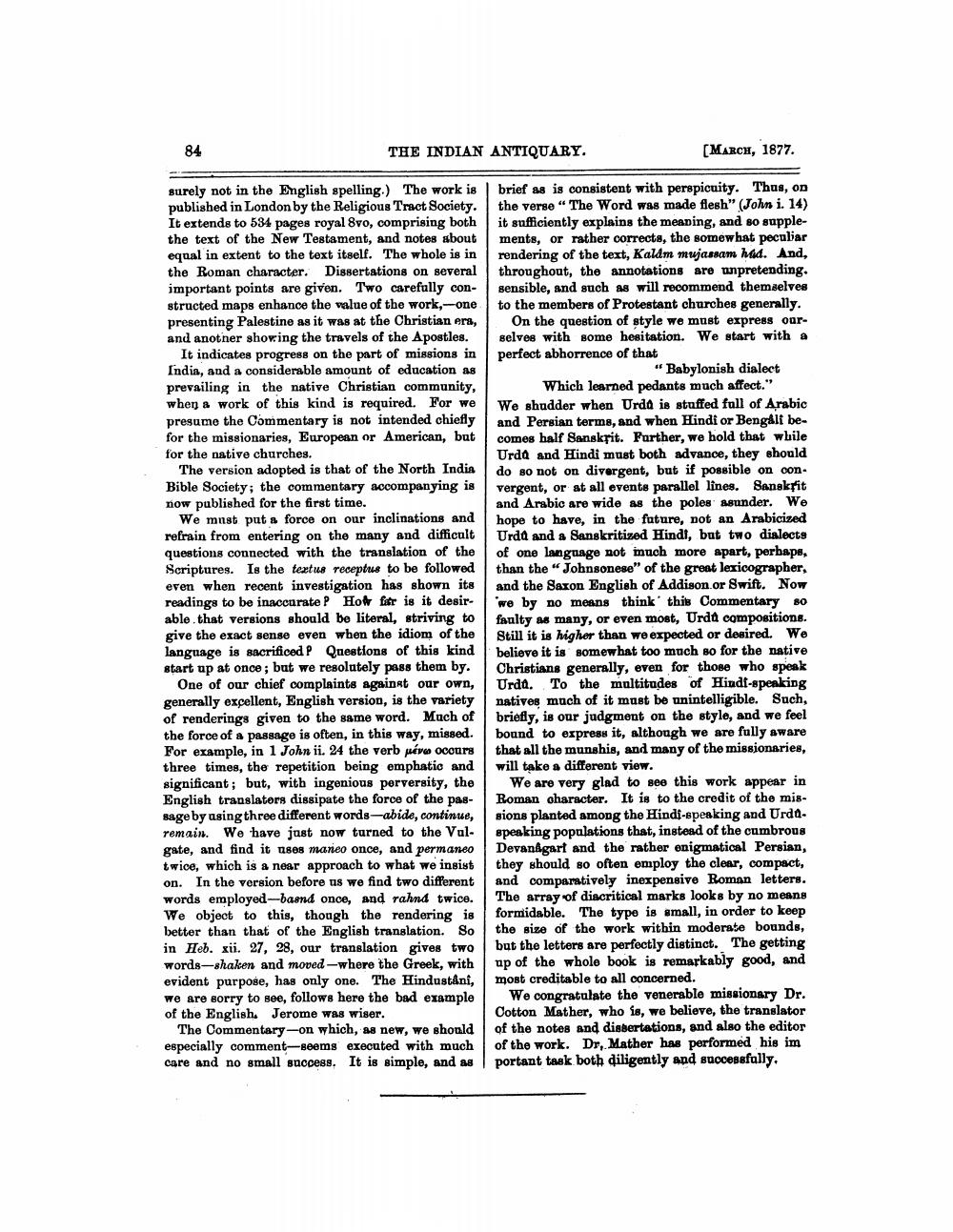________________
THE INDIAN ANTIQUARY.
[MARCH, 1877.
surely not in the English spelling.) The work is published in London by the Religious Tract Society. It extends to 534 pages royal 8vo, comprising both the text of the New Testament, and notes about equal in extent to the text itself. The whole is in the Roman character. Dissertations on several important points are given. Two carefully constructed maps enhance the value of the work.--one presenting Palestine as it was at the Christian ere, and another shoving the travels of the Apostles.
It indicates progress on the part of missions in India, and a considerable amount of education as prevailing in the native Christian community, when a work of this kind is required. For we presume the Commentary is not intended chiefly for the missionaries, European or American, but for the native churches,
The version adopted is that of the North India Bible Society; the commentary accompanying is now published for the first time.
We must put a force on our inclinations and refrain from entering on the many and difficult questions connected with the translation of the Scriptures. Is the textus receptus to be followed even when recent investigation has shown its readings to be inaccurate P How far is it desirable that versions should be literal, striving to give the exact sense even when the idiom of the language is sacrificed P Questions of this kind start up at once; but we resolutely pass them by.
One of our chief complaints against our own, generally excellent, English version, is the variety of renderings given to the same word. Much of the force of a passage is often, in this way, missed. For example, in 1 John ii. 24 the verb pávu cours three times, the repetition being emphatic and significant; but, with ingenious perversity, the English translators dissipate the force of the passage by using three different words-abide, continue, remain. We have just now turned to the Valgate, and find it nees maneo once, and permaneo twice, which is a near approach to what we insist on. In the version before us we find two different words employed-baend once, and rahnd twice. We object to this, though the rendering is better than that of the English translation. So in Heb. xii. 27, 28, our translation gives two words-shaken and moved-where the Greek, with evident purpose, has only one. The Hindustani, we are sorry to see, follows here the bad example of the English, Jerome was wiser.
The Commentary-on which, as new, we should especially comment-Beems executed with much care and no small success. It is simple, and as
brief as is consistent with perspicuity. Thus, on the verse "The Word was made flesh" (John i. 14) it sufficiently explains the meaning, and so supplements, or rather corrects, the somewhat peculiar rendering of the text, Kaldm mujassam had. And, throughout, the annotations are unpretending. sensible, and such as will recommend themselves to the members of Protestant churches generally.
On the question of style we must express ourselves with some hesitation. We start with a perfect abhorrence of that
"Babylonish dialect Which learned pedants much affect." We shudder when Urdd is stuffed fall of Arabic and Persian terms, and when Hindi or Bengali becomes half Sanskrit. Further, we hold that while Urdd and Hindi must both advance, they should do so not on divergent, but if possible on oonvergent, or at all events parallel lines. Sanskrit and Arabic are wide as the poles asunder. We hope to have, in the future, not an Arabicized Urdd and a Sanskritized Hindi, but two dialects of one language not inuch more apart, perhaps, than the “Johnsonese" of the great lexicographer, and the Saxon English of Addison.or Swift. Now 'we by no means think this Commentary 80 faulty as many, or even most, Urdd compositions. Still it is higher than we expected or desired. We believe it is somewhat too much so for the native Christians generally, even for those who speak Urdd. To the multitudes of Hindf-speaking natives much of it must be unintelligible. Such, briefly, is our judgment on the style, and we feel bound to express it, although we are fully aware that all the munshis, and many of the missionaries, will take a different view.
We are very glad to see this work appear in Roman character. It is to the credit of the missions planted among the Hindi-speaking and Urdd. speaking populations that, instead of the cumbrous DevanAgart and the rather enigmatical Persian, they should so often employ the clear, compact, and comparatively inexpensive Roman letters. The array of diacritical marks looks by no means formidable. The type is small, in order to keep the size of the work within moderate bounds, but the letters are perfectly distinct. The getting up of the whole book is remarkably good, and most creditable to all concerned.
We congratulate the venerable missionary Dr. Cotton Mather, who is, we believe, the translator of the notes and disbertations, and also the editor of the work. Dy, Mather has performed his im portant task both diligently and successfully,




